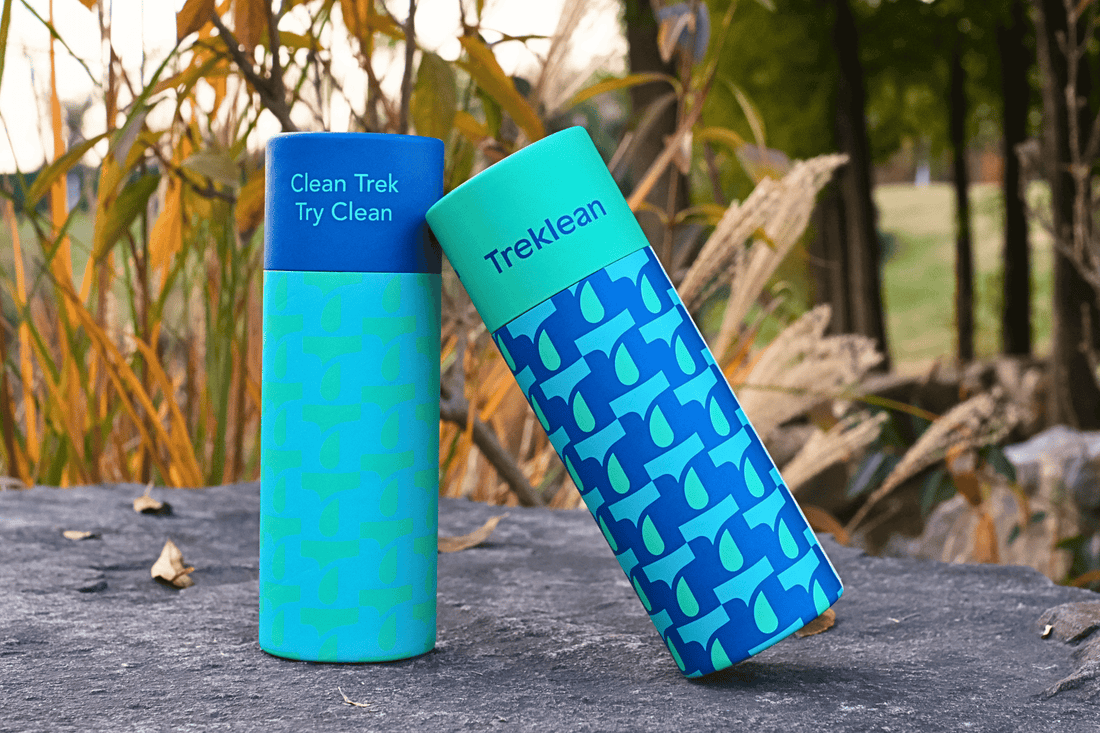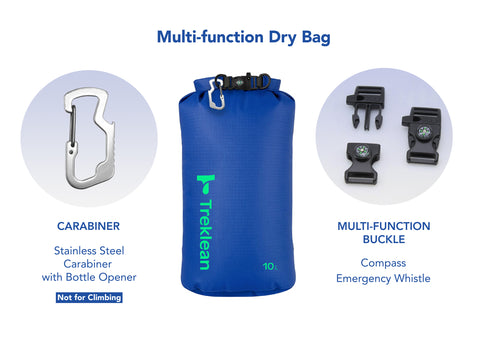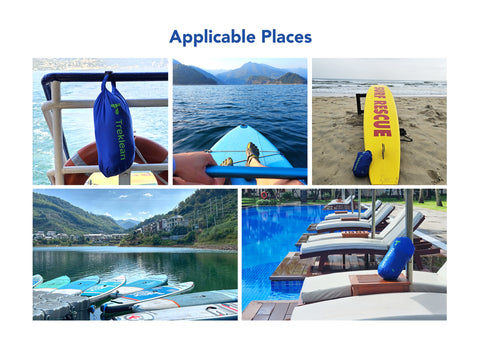
Dry Bag Essentials: The Ultimate Guide for Waterproof Protection
Imagine being on an exciting whitewater rafting trip, enjoying the adrenaline rush as your raft navigates the roaring rapids. But then, disaster strikes - you accidentally drop your backpack into the water, and all your belongings are soaked. How do you prevent such a predicament from happening? Enter the world of dry bags, your ultimate solution to keeping your items dry and protected during water-based outdoor activities. In this blog post, you will learn how to choose the right dry bag, essential accessories, expert tips for use and maintenance, and alternatives for different activities.
Key Takeaways
-
Choose the right dry bag based on size, capacity, material and closure system.
-
Utilize accessories such as attachment points, straps and purge valves for maximum convenience.
-
Ensure proper packing and sealing to maintain waterproof integrity. Clean after each use & inspect regularly for wear/damage.
Choosing the Right Dry Bag

Optimal waterproof protection depends on picking the right dry bag. Factors to consider when making your choice include:
-
Intended use
-
Size and capacity
-
Material and durability
-
Closure systems
By considering these factors, you can ensure that you choose a dry bag that meets your specific needs for waterproof protection.
Intended Use
The most suitable dry bag option depends on the specific activities and environments where it will be used. Will you be using it for kayaking, hiking, or traveling? Expert advice can help you choose the right dry bag for your needs.
Not all dry bags are created equal when it comes to attachment points. For those seeking multiple attachment points to secure their bag, options like the Yeti Panga 50 and NRS Expedition DriDuffel are worth considering. These dry bags feature numerous attachment points, ensuring your gear stays dry and secure during your whitewater adventures.
For water-bound adventurers who desire easy access to their items and want to stay organized, the Watershed Aleutian Deck Bag is an excellent choice.
Size and Capacity
Dry bags come in various sizes and capacities, usually measured in liters. They range from small 2-liter bags to larger sizes like 50, 60, or even 90 liters. The ideal dry bag should accommodate your gear and belongings, with the right gear capacity, without adding unnecessary bulk or weight.
For example, Treklean Ultralight Drybag with its 5-liter or 10-liter capacity, might not be suitable for long day trips. On the other hand, Treklean Drybag offers a lightweight, high-capacity option that can be easily stuffed inside another bag.
Material and Durability
Choosing a dry bag constructed from sturdy, waterproof fabric is key to ensure its durability and long-lasting protection. Nylon and polyester PVC tarpaulin are the most suitable fabrics for dry bags, as they are synthetic, durable, and water-resistant. A dry bag’s durability is further enhanced by robust construction techniques, such as heavy-duty seams that are double stitched, taped, and heat sealed, which prevent water from seeping in. Design features like multiple lash points and compression straps provide added reinforcement and stability.
However, not all dry bags can withstand every situation. Always consider the activities you will be participating in and the environments you will encounter when selecting a dry bag.
Closure Systems
Dry bags come with different closure systems, like:
-
Roll-top: lightweight and offer a secure seal, though not meant to be submerged
-
Zipper: more secure and provide a watertight seal, though heavier and pricier
-
Fold-down: lightweight and provide a secure seal, yet not intended to be submerged.
Essential Dry Bag Accessories

Enhancing your dry bag’s functionality with accessories like attachment points and straps, purge valves, and waterproof pouches can make your outdoor adventures more convenient and enjoyable.
We will now examine these essential accessories and their role in enhancing your dry bag usage.
Attachment Points and Straps
When selecting a dry bag, look for:
-
Stainless steel buckles, D-rings, or other attachment points for easy and secure attachment to watercraft or backpacks
-
Stainless steel buckles offer superior build quality and durability, greater rigidity and toughness compared to plastic or carbon steel buckles, and long-term durability
-
D-rings on dry bags provide attachment points for straps and carabiners, allowing securement of the bag to your body or other objects, preventing loss or damage.
Examples of dry bags with optimal attachment points and backpack straps include the Treklean Ultralight dry bag, which comes with robust and strategically placed D-rings for secure attachment, and the Yeti Panga, which boasts plentiful attachment points, ensuring your gear stays dry and secure during whitewater adventures.
Purge Valves
Some dry bags, like the SealLine Discovery View, come with purge valves that release excess air trapped within the bag without affecting water protection. This prevents the bag from “ballooning” and allows you to compress the bag to save space, making it more compact and easier to pack.
Purge valves can be found in various types, such as two-way purge valves for inflation, compression, or drainage, and simple air purge release valves to vent excess air contained within the bag.
However, Treklean Ultralight Drybag is not equipped with purge valves, this is because it is ultralight enough and easy to release the air. We will consider the purge valves design in larger dry bags.
Expert Tips for Using and Maintaining Your Dry Bag
The performance and longevity of your dry bag hinge on proper packing and sealing, regular cleaning and storage, as well as timely inspection and repair.
We will now share expert tips on using and maintaining your gear dry bag, so it can continue to protect your belongings in different outdoor activities.
Proper Packing and Sealing
To ensure a watertight seal, follow these steps:
-
Roll the top opening of your dry bag three times.
-
Secure it with the buckle or closure system.
-
Make sure to remove excess air as you roll the top down to create a tight seal.
Once the top is rolled down as far as possible, fasten the buckles or clips to keep the roll in place. This will create a watertight seal, keeping your items dry and safe during any water-based outdoor activity.
Cleaning and Storage
Clean your dry bag with mild soap and water after each use to remove dirt and debris that could compromise its waterproofing capabilities. Bronner’s unscented soap or Wilderness Wash is recommended for gentle yet effective cleaning.
After cleaning, hang the dry bag upside down in a well-ventilated area to allow it to air dry completely. Avoid exposure to direct sunlight, as it may cause the material to degrade over time.
Inspection and Repair
Regularly inspect your dry bag for signs of wear or damage, such as:
-
abrasion
-
tears
-
frayed seams
-
small holes
Repairing any issues promptly will maintain the waterproof integrity of your dry bag. Patch kits and adhesives, such as Gear Aid Seam Grip +WP, can be used for minor repairs.
For larger tears or holes, it’s recommended to consult the manufacturer or seek professional assistance.
Dry Bag Alternatives for Different Activities

Despite dry bags being an excellent choice for protecting gear during outdoor activities, other options might better suit certain needs. We will now look into alternatives such as waterproof backpacks, dry sacks, and waterproof cases for gear protection and organization.
Waterproof Backpacks
Ideal for hiking or traveling, waterproof backpacks offer more storage and organization options than traditional dry bags while still providing excellent water protection. These backpacks often come with additional features, such as:
-
Comfort and fit
-
Durability
-
Ventilation
-
Hydration compatibility
Leading brands like MARCHWAY, Earth Pak, YETI, Patagonia, The North Face, Sea to Summit, Ortlieb, and Mountain Hardwear offer a variety of waterproof backpack options to suit your needs.
Dry Sacks
Lightweight and compact, dry sacks are perfect for use inside larger bags or backpacks to keep specific items dry and protected. These sacks are designed to be used for carrying items in a backpack or travel bag, and they are made from lightweight materials like silnylon.
Dry sacks provide an additional layer of protection for your belongings, especially when used in conjunction with a waterproof backpack or larger dry bag.
Waterproof Cases
For added protection of electronics or sensitive equipment, consider waterproof cases designed to withstand submersion and impact. These cases are constructed from materials like:
-
Rubber
-
Plastic
-
Metal
-
Neoprene
-
Polyurethane
-
Polycarbonate
-
Acrylic
These materials ensure that your valuable items remain safe and dry even in extreme conditions when stored in a store.
Waterproof cases can be a beneficial choice for activities such as boating, kayaking, canoeing, snorkeling, and any other water sport that requires protecting belongings from water damage.
Summary
In this blog post, we have explored the world of dry bags and their essential role in keeping your belongings dry and protected during water-based outdoor activities. We have discussed the factors to consider when choosing the right dry bag, essential accessories, expert tips for use and maintenance, and alternative options for different activities. With this knowledge, you are now better equipped to choose the right dry bag and accessories for your needs, ensuring a worry-free outdoor adventure.
Frequently Asked Questions
What is the purpose of a dry bag?
A dry bag is a waterproof reservoir used to protect electronics, clothing, and other belongings from water damage. They are often used for boating, fishing, camping, or hiking to keep items dry in wet or humid environments.
What is the difference between a wet bag and a dry bag?
A dry bag is designed to keep belongings dry, while a wet bag is used for storing wet items. A dry bag can also be used as a wet bag, but only for the purpose of keeping water inside.
Can you fully submerge a dry bag?
You can fully submerge a dry bag by rolling the top down tightly at least three or four times to create a tight seal. Alternatively, Swim Secure's range of floating dry bags also have a roll top seal, as well as their bum bags and waterproof phone cases using a triple zip-lock and roll system.
Are dry bags actually waterproof?
Dry bags are designed to be 100% waterproof, though this only holds true to a certain depth. Factors such as increased pressure can stress materials and weak points, limiting the waterproof capabilities.
What is an alternative to dry bags?
Plastic bags can be an effective alternative to dry bags - they will help keep your gear dry, weigh only 5 ounces and cost virtually nothing. While they may not be as durable as a stuff sack, they can still do the job for most situations.
